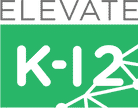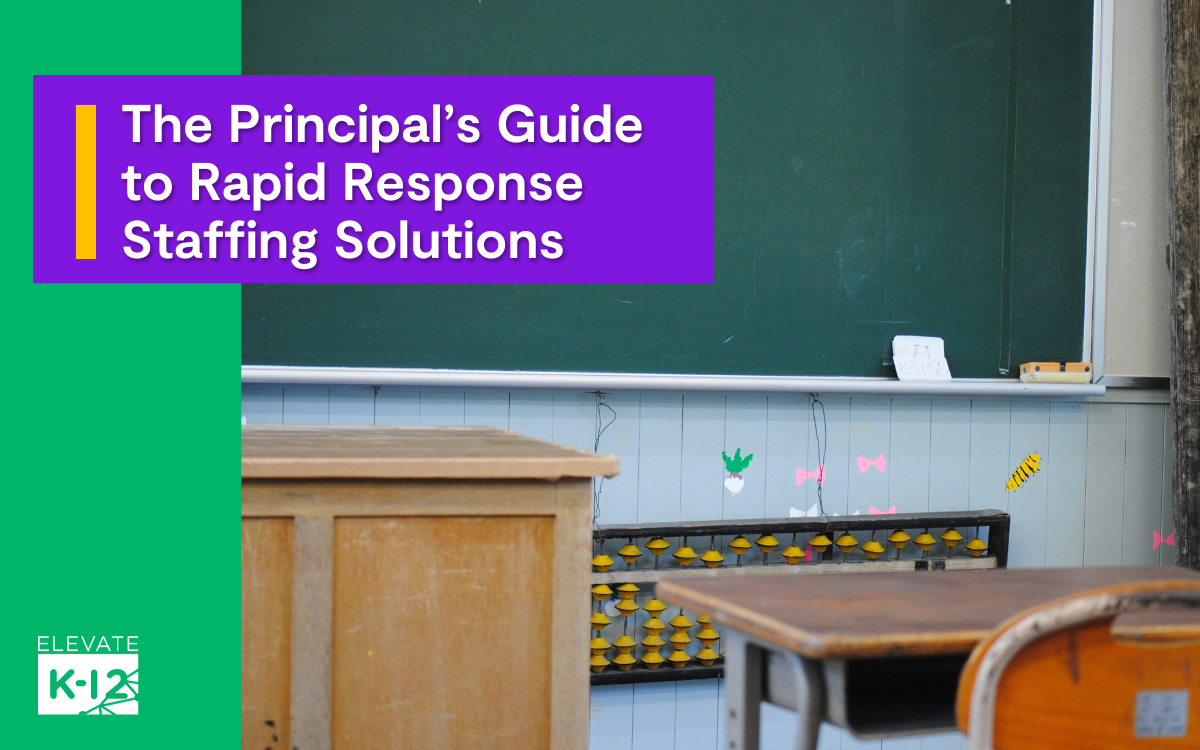When Every Day Counts
The first weeks of school set the tone for the entire year. For principals, they are also the weeks when every hour counts, when routines take root, relationships form, and learning momentum builds.
Many principals are starting this year already in a sprint. Maybe you held out hope that the perfect in-person hire would come through before the first bell rang, only to have the position still vacant on day one. Maybe you did fill it, but a last-minute resignation or unforeseen circumstance has left the classroom empty again. Or maybe a policy change or certification shift pulled a teacher off your roster without warning.
Whatever the reason, the challenge is the same: how to keep students learning and classrooms stable without lowering the bar for instructional quality.
This rapid response staffing solutions guide is built for that exact moment. Whether you are managing a same-day absence, a brand-new vacancy, or a mid-semester disruption, you will find practical ways to keep instruction consistent, culture strong, and your school year on track.
The Three Time Horizons of Staffing Response
Not all staffing challenges are the same, and the best solution depends on how quickly you need to act. Thinking in three time horizons can help you respond with both speed and strategy.
Immediate – Day 1 to 2 Weeks
The priority in this window is to prevent disruption for students and maintain daily routines.
- Reassign available staff within the building to cover critical classes.
- Use internal float staff or instructional coaches to provide short-term coverage.
- Engage day-one-ready certified teachers from trusted partners who can step in quickly and keep lessons aligned with your curriculum.
Mid-Term – Weeks 2 to 8
Once the initial scramble is over, the focus shifts to sustaining instructional quality until a permanent plan is in place.
- Ensure interim or substitute teachers have access to pacing guides, lesson plans, and instructional resources.
- Provide extra coaching or classroom management support for temporary staff.
- Consider hybrid models or LIVE teaching to maintain rigor and consistency without overburdening existing staff.
Long-Term – Beyond 8 Weeks
Vacancies that last longer than two months can take a toll on both culture and achievement. Planning for the long haul reduces the risk of repeated disruption.
- Build a reliable bench of vetted, qualified educators who can step in when needed.
- Strengthen communication channels with district leadership to flag vacancies early.
- Partner with providers who can scale coverage up or down as enrollment, policy, or staffing needs change.
The Ripple Effects of Staffing Gaps on School Culture
A vacant classroom is never just a scheduling problem. The effects can ripple across the building in ways that impact learning, morale, and even community trust.
Student Behavior and Engagement
When instruction is inconsistent, students notice. Gaps in routines and expectations can lead to disengagement, more off-task behavior, and a harder time regaining focus once stability returns.
Teacher Morale and Burnout
Vacancies often mean other teachers are asked to take on extra duties, cover classes, or give up planning time. Even the most committed staff can feel stretched thin, leading to frustration and increased burnout risk.
Parent Confidence
Families expect steady, high-quality instruction for their children. When they see a revolving door of substitutes or missed instructional days, trust in the school’s ability to deliver can waver.
School-Wide Culture
Stability in the classroom reinforces stability across the school. When students know what to expect and teachers feel supported, the tone in hallways, common spaces, and extracurriculars improves, too.
Research shows that teacher vacancies can directly impact student achievement, with learning gaps widening the longer a position remains unfilled (Teachers on Demand, 2024). Addressing staffing gaps quickly is not only about filling a position. It is about protecting the culture you work all year to build.
Core Principles of Rapid Staffing Response
Responding quickly to a staffing gap does not have to mean lowering expectations. The most effective principals follow a few core principles to stabilize classrooms without sacrificing quality.
Stability First
Keep daily routines, schedules, and classroom expectations intact so students experience as little disruption as possible. Consistency is a key driver of both academic performance and behavior.
Quality Matters
Filling a seat is not enough. Students need certified teachers who can engage them in meaningful learning from day one, even in a short-term or interim capacity.
Clear Communication
Keep your staff and families informed about how instruction will continue. Transparency builds trust and reduces anxiety during transitions.
Leverage Partnerships
You do not have to solve staffing challenges alone. Strategic partnerships can provide certified, day-one-ready teachers and support systems that allow you to focus on leading your school.
Monitor and Adjust
Check in frequently on student engagement and instructional quality. Early feedback helps you make quick adjustments before small issues grow into bigger problems.
Practical Steps to Put This Into Action
When a staffing gap appears, speed and structure matter. Having a clear process in place helps you act quickly while keeping quality high.
The 7 Step Rapid Staffing Response Action Plan
1. Identify the Vacancy and Assess Urgency
Determine the subject, grade level, and immediate impact on the schedule. Knowing how critical the position is to daily operations helps you prioritize next steps.
2. Secure Short-Term Coverage
Use available internal staff, floaters, or instructional coaches to keep the class running while you line up a longer-term solution.
3. Engage Certified, Ready-to-Teach Support
Tap into a trusted partner who can provide a certified teacher who meets state requirements, aligns with your curriculum, and is prepared to start right away.
4. Maintain Consistency for Students
Share lesson plans, pacing guides, and routines with whoever is stepping in. Consistency in instruction and expectations keeps students engaged and learning.
5. Support On-Site Staff
Assign a point person to help the incoming teacher or substitute with classroom management, technology, and student needs during the transition.
6. Communicate with Families and Staff
Let parents and staff know how instruction will continue and when they can expect stability. Clear communication reassures the community that learning will not stall.
7. Monitor and Adjust
Check in on student engagement, lesson delivery, and classroom culture. Use these observations to make quick improvements or additional supports.
Where Principals Can Find Day-One Ready Teachers
When a vacancy appears, the ideal solution is a teacher who is both qualified and ready to step in immediately. That means more than just filling the space at the front of the room. The right fit is:
- Certified in the subject and grade level you need
- Experienced in engaging students and managing a classroom
- Aligned with your curriculum and pacing
- Equipped with the technology and support to start teaching on day one
Some principals maintain their own pool of reliable substitutes or retired teachers. Others build relationships with staffing partners who can deliver certified educators quickly and integrate them into existing school systems.
With LIVE teaching from Elevate K-12, principals can meet all of these needs in a single solution. Every Elevate teacher is U.S.-based, state-certified, and an experienced subject-matter expert with an average of 15+ years in the classroom. They are trained specifically in virtual engagement strategies, ensuring students stay connected and actively learning.
Instruction is fully aligned to your district’s standards and pacing. Elevate integrates seamlessly with your existing curriculum, LMS, and school systems, so teachers can start delivering lessons that fit your scope and sequence from the very first day.
In every LIVE classroom, the district provides an on-site Classroom Coach—often a paraprofessional—who manages the physical classroom environment and supports students during lessons. Elevate ensures the Classroom Coach is fully prepared through onboarding, training, and ongoing support so they can work in tandem with the LIVE teacher for a seamless student experience.
Our turnkey model also includes the classroom technology, interactive tools, and a 360° support team handling tech setup, ongoing coaching, quality assurance, and caregiver communication, so your focus stays on leading your school.
Acting Fast Without Lowering the Bar
Staffing gaps will always be a reality in schools, but they do not have to derail learning or weaken school culture. With a clear plan, the right partnerships, and a commitment to quality, principals can respond quickly while keeping instruction strong and routines intact.
When the unexpected happens, your students still deserve engaging, consistent teaching, and your teachers deserve the support to focus on their own classrooms. Acting fast is important, but acting with purpose is what keeps your school on track.
Start building your rapid response plan now, before the next vacancy appears. If you are ready to explore options for certified, day-one-ready teachers who can integrate seamlessly into your school, we would love to talk with you and share how Elevate K-12 can help make it happen.

